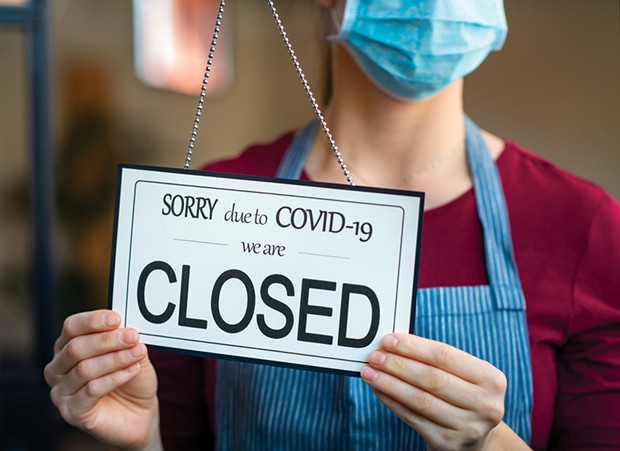[
{
"name": "Top Stories Video Pair",
"insertPoint": "7",
"component": "17087298",
"parentWrapperClass": "fdn-ads-inline-content-block",
"requiredCountToDisplay": "1"
}
]
It's a such a shame," is a phrase we hear a lot when a restaurant shuts down. Since the shelter-in-place order came down in March, it's been on constant loop as dining rooms and storefronts have gone dark around us. Owners and staff who have managed to hang on — careening from complete closure to takeout only, to outdoor dining, to indoor dining, then back again to outdoor and takeout — have described the experience again and again as "a rollercoaster."
In the beginning, there were rallying cries to buy branded T-shirts and gift certificates to be redeemed "when this is all over," then we learned to tip for takeout to support our favorite establishments and their workers. Many who have the means to do so, and who feel comfortable enough with varying increases in risk, have made their way to dining at picnic tables, in wedding tents and, lately, in half-empty dining rooms. But in the long run — and health experts tell us this will be long — it will not be enough. To save our bars and restaurants, we need to think bigger and take real responsibility for slowing the spread of the virus.
Along with Payroll Protection loans and, in some cases, drastic pay cuts for owners, takeout and various dining configurations have made it possible for some restaurants to scrape by. But with the exception of a handful of businesses whose models hold up to shelter in place — some trucks and grab-and-go operations have cautiously said they are actually turning profits — most are operating on a knife's edge.
Even in areas safe from encroaching fires last week, the smoke made newly built parking lot patios and parklets useless (along with the extra insurance restaurants paid to use them), demonstrating how easily a shift in conditions leads to losses. The rain we're now all praying for will likely wipe out outdoor dining as well. If it does come, there'll be few precious weekends left before heat lamps and lap blankets won't be enough to attract diners.
Indoor dining, too, is precarious. Monday's new COVID-19 case tally of 26, which came with one more death and one more hospitalization, puts us on pace to land in the red "substantial" risk zone in the coming weeks. If that happens, indoor dining will be restricted further, leaving many food businesses with a takeout-only model that doesn't meet the overhead of rent, payroll and inventory, not to mention the countless other expenses that come with running a restaurant.
Even now, safely in the "moderate" orange zone, some restaurant and bar owners and workers (many of whom have inadequate health insurance) are forced to pencil out their own health risks versus economic survival. Others are squeezed enough to consider bending or breaking the rules set down by health officials to keep the public safe and hopefully get us to a place where those very restrictions can be loosened. Even in this zone, we are losing restaurants, bars and other food businesses. And with them, along with a business sector already battered by a faltering economy, go hubs of community connection.
When we lose restaurants and bars, we lose the corner tables over which nervous people propose. We lose the career wait staff sprinting between tables to greet regulars. We lose being regulars. We lose the birthday dinners and the commiseration drinks. We lose everyone cramming around one end of the table while the server takes one more photo. These are the places where our economy, culture and daily lives intersect, and when they are gone it will be more than a shame, it will hurt.
Gov. Gavin Newsom's Great Plates program, which set restaurants up to make meals to be delivered to homebound seniors during shelter in place, showed some promise. However, as Eureka Mayor Susan Seaman told the Journal in an email, its "bureaucratic red tape" proved impractical for the city. Yet it opens the imagination to possibilities for real government intervention and support beyond what we can do by ordering takeout fried chicken or tacos once a week — the kind of small business aid we should be demanding from our representatives.
Whether or not our government intercedes meaningfully on behalf of the hospitality sector, which employs nearly 5,000 people in Humboldt County, there are greater sacrifices than eating takeout that we all need to make, starting with wearing a mask and staying home as much as possible. Want your favorite spot to be here in six months? Slowing the spread of COVID-19 is the only way we keep from shuttering indoor and outdoor dining entirely. We're a small county on the margin, so it only takes a handful of cases — seven new cases over the span of a week, which your dinner party could potentially rack up — to push us over the edge, potentially taking that neighborhood restaurant with us.
Every time we bring households together or attend gatherings, we risk a jump in positive COVID-19 cases and, in turn, the closure of places we'd miss when their owners can no longer afford or justify the strain to keep them going. That would be a shame. And it would be ours.
Jennifer Fumiko Cahill (she/her) is the arts and features editor at the Journal. Reach her at 442-1400, extension 320, or [email protected]. Follow her on Twitter @JFumikoCahill.
more from the author
-
Eco Cemeteries, Flags, Impacts and Foods
- Apr 12, 2024
-
Sunken Seaweed's Dual Mission
Stocking shelves and the ocean with seaweed and kelp
- Apr 11, 2024
-
Alternative Energy Brainstorming with Billionaires
- Apr 11, 2024
- More »

































